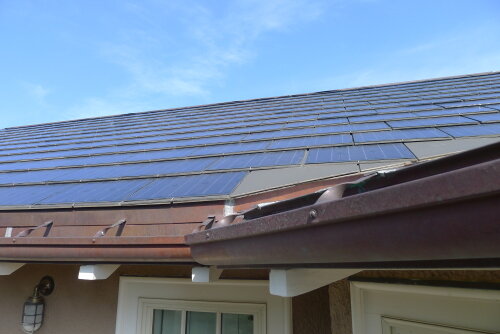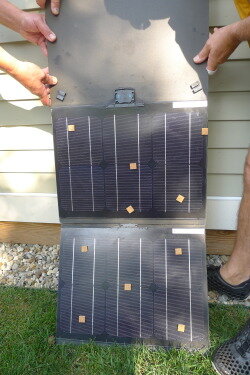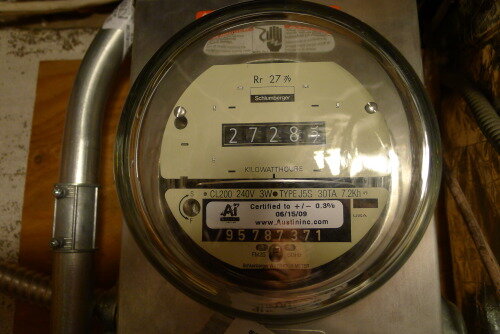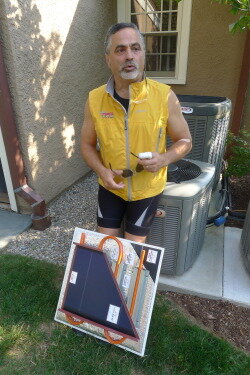Home of the Sun King: Solar Shingles in MA (October 13, 2012)
Late last August, when the sun’s power was at its peak, Kevin and I drove to Gloucester to meet a solar roofing pioneer I’ve been pestering since June: Tom Zarrella, President and CEO of SustainX, an energy storage firm in Seabrook, NH. Before the start of banking hours, he and his wry and patient wife, Kristin, welcomed us into their exquisitely landscaped 1920s Craftsman-style villa with solar shingles—convincingly made to resemble slate (shown above on their south-facing rear roof, and in close-up below).

Unlike ordinary solar panels, which sit atop an existing roof, the Zarrella’s shingle-sized panels are the roof, known as SunSlates—building-integrated photo voltaics (BIPV) from Atlantis Energy, based in Poughkeepsie, NY.

Each panel is made of glass embedded with photosensitive cells. Like any other battery, they produce a direct current, which channels through an inverting system in the Zarrella’s basement, converting the power to an alternating current for use throughout the house.
The average American home uses 14,000kw hours per year, according to the Department of Energy. That’s a little more than half what the Zarrellas have generated since they installed their system in October 2010, fewer than two years ago (as you can see on the meter below). The Zarrellas usage is higher than average, but if they generate more power than they utilize, that excess wattage is metered back to the grid system.


The heating system is more complicated. Beneath the slates run these orange plastic tubes filled with nontoxic glycol from Dawn Solar; Tom says they work like a sub-floor radiant heating system. When the slates heat up, they in turn heat the glycol, which runs down to a storage tank in the basement. From there it takes two paths, into either a standard hot water heater, which feeds all the spigots in the house, or into a forced-hot-air heating unit. The glycol is cold by the time the furnace and hot water heater release it, but from there a pump runs it back up to the roof for reheating, and the cycle repeats. (The Zarrellas use oil only as a backup fuel for the furnace.)
The sun powers 30 to 50% of the Zarrella’s electricity, heat, air-conditioning, and hot water—even though Tom says their energy usage is “huge.” Their place is 5,000 square feet, with central air conditioning and an outdoor pool they heat year-round.
Solar shingles on our house would cover a much higher percentage of our energy costs. The entire place is about 2,000 square feet. It’s just the two of us. In summer, we use AC only in our bedroom. And in the evenings, we tend to hang in the same room and turn out lights elsewhere. Finally, our furnace runs on oil-fueled forced hot air, but we’ll use it only as needed after installing a hyper-efficient wood-burning fireplace insert, powered by naturally felled trees in the 700-acre forest surrounding our house.
We’re also ideally situated for solar. Tom and Kristin gushed when they saw a photo of our south-facing front roof, given the pitch, the size, and the unobstructed southern exposure.
Tom would know. A pioneer in the American solar industry, he’s directly behind at least one recent industry trend: As CEO at GT Solar (2006-2009), he sold complete solar panel production lines to the Chinese and taught them how to run them. They’re now cranking out solar panels so inexpensively that many U.S. roofers are installing them for no money down. Rather than pay for the pricey gear, homeowners lease it for the first twenty years, essentially paying a fixed rate for the power itself—far cheaper than standard electric and heating expenses—making solar an accessible renewable energy.
Still, solar power remains a pipe dream for us. Clunky conventional panels are out of the question for a historic restoration like ours. To use solar shingles, which from street level resemble historically appropriate slate, we’d need approval from the MA Department of Conservation & Recreation, which owns the building we’re restoring as resident curators. ForAtlantis Energy’s shingles, it would cost about $21,000 (after incentives) to do our 1,000 sq. ft. front roof. Most prohibitively, Atlantis’s heavy tiles would overtax our old post and beam frame, which was built to support wood shingles, not slate. Dow has started selling lighter solar shingles on the west coast, but they won’t be available on the east coast for some time, and we need a new roof now.
Tom says a viable alternative for us may be a ground-mounted system. We’d still need state approval, but it’s less likely they’ll object if the system is invisible from the street, freeing our consciences to install the most historically correct roof: wood shingles.

Visually, they’re my favorite option—particularly in the way they can make a house look like it’s been growing there, as shown here on the Old Manse, Ralph Waldo Emerson’s home in Concord. All things considered, a ground mount might grant us the best of both worlds—and hope for an even greener, cleaner, better one.

